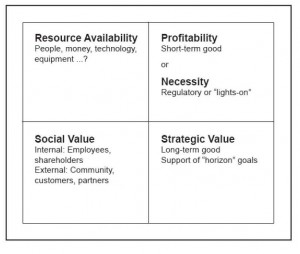Blue-Horizon, Lights-On, and Bread-and-Butter: Balancing the Bad Times Portfolio
I'm still digesting that Accenture research on what companies that emerged strongly from the 1990-91 downturn did differently during the bad times. As I said in my previous post, this is one of those business news articles that is all about portfolio management, without ever mentioning it.
I suspect that is because a lot of companies - and many management researchers - don't know there is a name, a history, a set of standards and best practices - for what they are trying to do.
A key finding, for me, was that the most successful companies had a keen insight into their business. Now, this might sound elementary, but 15 years in business journalism have taught me that business is not as rational as you might think. Companies frequently have no idea what is going on within and across departments; duplication of effort is therefore the norm rather than a fluke; and lacking any systematic measurement system, they also have trouble knowing what is working and what isn't.
That's why implementing project portfolio management (PPM) usually results in some AHA! experiences. "You mean ... we were doing THAT? ... three times?" and the resulting cost savings.
So, PPM is one of those project management tricks that both saves money ... and allows companies to invest in some "blue horizon" projects that will carry them forward. A tuck here, and let out a seam there, and you can take the "stitch in time" that lays the ground for growth.
But, there's another aspect of PPM that's also in line with the research linked to in my earlier post. With apologies for the resolution on this graphic, check out the Portfolio Scorecard model we proposed in our book, Seven Steps to Strategy Execution: [caption id="attachment_235" align="aligncenter" width="378" caption="Balancing with realism means taking resources into consideration"] [/caption]
[/caption]
Now, usually, you'd see the profitable projects ("bread and butter" projects is one nickname for these) and the necessary ones in two blocks of that square. But, in fact, they fall into the same category. You are going to do these things ... no matter what. Either they are required, or they make money (rarely both) and so they are IN.
What's missing from the balance equation in many models is the upper left quadrant: Do we have the capacity to do this? The people, the skills, the cash ... the software, the space, the ideas: the resources that, without which any list of projects is just a wish list.
- Live from Atlanta ... People, Ideas and More, Part 2
- Live from Atlanta ... People, Ideas and More
- PM Skills Benchmark Study: Your Second Chance to Participate
- Managing Projects…Or Delivering Value? Eric Foss’s Challenge to Project Managers
- Will A.I. Kill the PMO? Part 3 in Our A.I. in PM Series
- The PMO at 20: New Research Findings Released
- Something to Be Thankful For
- Your Questions, Answered: Part One -- What About PMBOK7?
- Project Management Carried On During 2020: Here's How
- The State of Project Management 2020: Webinar Attendee Questions Part 3
- The State of Project Management 2020: Webinar Attendee Questions Part 2
- Download New Research Report Today: State of PM 2020
- Four Things to Do Right Now: Insights from New Research
- Project Management as a Service: A New Spin on A Time-Tested Strategy
- Join Us on an Agile PMO Journey
- State of PM 2020: Survey Deadline Extended One Week!
- Now or Never: What Is the State of PM in 2020?
- New Research Survey Launched Today!
- New White Paper Released Today
- @PMOSym We Debrief Our Execs
- It's a Wrap: Day 4 @PMOSym
- Blogging from the PMO Symposium: Day Three -- A Quest
- Blogging from the PMO Symposium: Day Two
- Being Aware of Cybersecurity Threats is Spooky
- The View from PMI50: Winds of Change
- The View from PMI50: Non-Conformists Move the World
- Whose Skills are Lacking, Exactly?
- At ATD 2019: Two Views of the Human Factor at Work
- Blogging from the ATD Conference
- Tra-la, It's May! Stay Positive, People
Related Posts:
Tags:
(24 votes. Average: 2.5 out of 5)
Popular Posts
- The Project Management Maturity Model … Now with Agile/Adaptive Assessment!
- PM Solutions Celebrates 25 Years of Project Management Excellence
- Managing Project Managers Within and Outside the PMO
Popular Categories
- Agile or Adaptive PM (5)
- Culture & Change Management (75)
- Project & Program Management (82)
- Portfolio Management (50)
- Project Management Office (PMO) (107)
- Project Management Research (50)
- Resource Optimization (26)
search blog:
Sign up for PM Solutions'
Insights eNewsletter
Delivered every other month in addition to periodic research, white papers, and news alerts.




No comments yet. Be the first one!